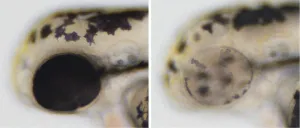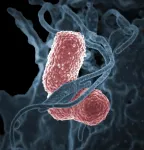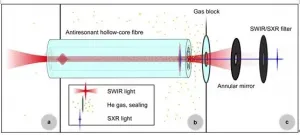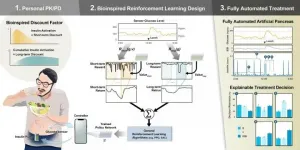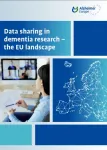(Press-News.org) To discover the function of a gene researchers turn it off and observe the consequences. Often genes have multiple functions that differ depending on a tissue and age. Some genes are essential to growth and turning them off too early can have profound consequences that can make observing other functions impossible. To avoid it, researchers have been using conditional gene inactivation which allows turning a gene off only in a specific tissue or later in development, e.g., in adulthood.
One of the systems used for conditional gene inactivation is Cre/lox. "It is the gold standard for the conditional gene inactivation in mice but over time has also become quite important in other model organisms such as zebrafish," says Dr. Stefan Hans, researcher at the CRTD and author of the study. The Cre/lox system relies on an enzyme, known as Cre recombinase, and special sequences, known as lox. The lox sequences are inserted into the genome around the gene of interest.
Cre recognizes the lox sequences and removes the gene sandwiched between them. In such a way, the gene is turned off and will not be expressed in this cell. Over the years, the research community developed many lines of animals in which Cre recombinase is only present in a specific tissue. Using such Cre lines, it is possible to turn a gene off only in one tissue but not in the others.
Although commonly used, flanking a gene with lox sequences has its disadvantages. "Inactivating a specific gene takes a lot of time and effort. It requires sophisticated genome modifications and can take multiple generations of animals until the setup is ready for an experiment," explains Dr. Hans. "Compared to the method we established, it is slow and very laborious," he adds.
Cre-Controlled CRISPR, the new method developed by a team of Dresden researchers led by Prof. Michael Brand, combines the benefits of the Cre/lox system with the CRISPR/Cas9 genetic scissors. The CRISPR/Cas9 system is a relatively new method that quickly revolutionized life sciences and led to 2020 Nobel Prize in chemistry. Although simple to use in general, CRISPR/Cas9 is not easily limited to just one tissue, which means that adapting it to conditional gene inactivation takes time and effort.
"In Cre-Controlled CRISPR we are taking advantage of the tissue-specific expression of Cre and the ease of gene editing of CRISPR/Cas9," says Dr. Hans. "By merging the two methods, we created a version of CRISPR/Cas9 that is switched on by a Cre recombinase. Using our method, researchers can still take advantage of vast libraries of already established animal lines that express Cre in different tissues. But Cre-Controlled CRISPR takes away the laborious genome editing because it removes the necessity to flank a gene with lox sequences. It actually requires adding only one sequence to the genome, no matter what the gene of interest is," explains Dr. Hans. Without the need to sandwich a gene between the lox sequences, Cre-Controlled CRISPR is faster and easier.
The Cre-Controlled CRISPR is not only simpler to establish but, just as CRISPR/Cas9, it also offers the possibility to turn off multiple genes at a time. What is more, the CRTD researchers engineered their method to facilitate subsequent analyses of the cells were Cre-Controlled CRISPR was used. Once the CRISPR/Cas9 is turned on, the cells are labeled with a green fluorescent protein (GFP). Fluorescent proteins such as GFP are commonly used in life science and provide countless methods to separate the labeled cells from others to use them for further experiments, e.g., next generation sequencing or others.
"Although we developed Cre-Controlled CRISPR as a proof of concept in zebrafish, the method is versatile and should be applicable to other model organisms as well," adds Dr. Hans.
INFORMATION:
Publication
Stefan Hans, Daniela Zöller, Juliane Hammer, Johanna Stucke, Sandra Spieß, Gokul Kesavan, Volker Kroehne, Juan Sebastian Eguiguren, Diana Ezhkova, Andreas Petzold, Andreas Dahl and Michael Brand: Cre-Controlled CRISPR mutagenesis provides fast and easy conditional gene inactivation in zebrafish. Nature Communications (February 2021)
About the Center for Regenerative Therapies Dresden (CRTD)
The Center for Regenerative Therapies Dresden (CRTD) of TU Dresden is academic home for scientists from more than 30 nations. Their mission is to discover the principles of cell and tissue regeneration and leveraging this for recognition, treatment and reversal of diseases. The CRTD links the bench to the clinic, scientists to clinicians to pool expertise in stem cells, developmental biology, gene-editing and regeneration towards innovative therapies for neurodegenerative diseases such as Alzheimer's and Parkinson's disease, hematological diseases such as leukemia, metabolic diseases such as diabetes, retina and bone diseases.
Since 2016 the CRTD is part of the central scientific unit "Center for Molecular and Cellular Bioengineering" (CMCB) of the TU Dresden and plays a central role within the research priority area Health Sciences, Biomedicine, and Bioengineering of the TU Dresden.
Web: http://www.tu-dresden.de/cmcb/crtd
Web: http://www.tu-dresden.de/cmcb
About DRESDEN-concept Genome Center (DcGC)
The DcGC is a joint sequencing center of the Deep Sequencing Core Facility at the Center for Molecular and Cellular Bioengineering (CMCB) of the TU Dresden and the Sequencing Facility of the Max Planck Institute of Molecular Cell Biology and Genetics (MPI-CBG). It is one of four DFG-funded German competence centers for next generation sequencing. The DcGC is an amalgamation of employees working at the CMCB, MPI-CBG, as well as Center for Systems Biology Dresden (CSBD). DcGC consists of three platforms focusing on long read sequencing technologies, single cell sequencing, and short read sequencing, covering the experimental workflows and the bioinformatic analysis.
New storage and information technology requires new higher performance materials. One of these materials is yttrium iron garnet, which has special magnetic properties. Thanks to a new process, it can now be transferred to any material. Developed by physicists at Martin Luther University Halle-Wittenberg (MLU), the method could advance the production of smaller, faster and more energy-efficient components for data storage and information processing. The physicists have published their results in the journal "Applied Physics Letters".
Magnetic materials play a major role in the development of ...
The way a fish swims reveals a lot about its personality, say scientists
Personality has been described in all sorts of animal species, from ants to apes. Some individuals are shy and sedentary, while others are bold and active. Now a new study published in Ecology and Evolution has revealed that the way a fish swims tells us a lot about its personality.
This new research suggests experts can reliably measure animal personality simply from the way individual animals move, a type of micropersonality trait, and that the method could be used to help scientists understand about personality differences in wild animals.
A team of biologists and mathematicians from Swansea University and the University of Essex filmed the movements of 15 three-spined stickleback ...
A new analysis of B cells and more than 1,000 different monoclonal antibodies from 8 patients with COVID-19 shows that, contrary to previous hypotheses, protective B cell responses to the SARS-CoV-2 spike protein remain stable and continue to evolve over a 5-month period, many months after the initial period of active viral replication. However, a large proportion of the neutralizing antibodies generated from these long-lasting B cells did not efficiently recognize various emerging SARS-CoV-2 variants from Brazil and South Africa. These results - from an academia-industry collaboration - will help inform the design of future COVID-19 vaccines that work to constrain viral evolution and stimulate ...
Researchers have pinpointed a helper T cell population in the lungs of patients with severe COVID-19 that may be central to the development of hyperinflammation, lung injury, and subsequent acute respiratory distress syndrome (ARDS) during disease. Their data support the ongoing investigation of anti-cytokine therapies that target this cell subset, called tissue-resident memory-like Th17 cells (Trm17). To date, the bulk of research on immune responses to COVID-19 has mainly focused on T cells in the blood, while the role of tissue-specific immune cells in the inflamed lung has remained unclear. Accumulating evidence suggests that one of the causes of ...
WHAT:
Using viruses instead of antibiotics to tame troublesome drug-resistant bacteria is a promising strategy, known as bacteriophage or "phage therapy." Scientists at the National Institutes of Health have used two different bacteriophage viruses individually and then together to successfully treat research mice infected with multidrug-resistant Klebsiella pneumoniae sequence type 258 (ST258). The bacterium K. pneumoniae ST258 is included on a CDC list of biggest antibiotic resistance threats in the United States. High rates of morbidity and mortality are associated with untreated K. pneumoniae infections.
Phage therapy has been pursued for about a century, though conclusive research studies are rare and clinical results--from ...
Imagine if surgeons could transplant healthy neurons into patients living with neurodegenerative diseases or brain and spinal cord injuries. And imagine if they could "grow" these neurons in the laboratory from a patient's own cells using a synthetic, highly bioactive material that is suitable for 3D printing.
By discovering a new printable biomaterial that can mimic properties of brain tissue, Northwestern University researchers are now closer to developing a platform capable of treating these conditions using regenerative medicine.
A key ingredient to the discovery is the ability to control the self-assembly processes of molecules within the ...
Bright, coherent soft X-ray radiation (SXR) is used in many scientific applications such as advanced absorption spectroscopy or lens-less imaging, and in fundamental research e.g. to produce extremely short isolated optical pulses. Therefore, the generation, control, and detection of this type of short-wavelength light is highly important in fields like fundamental atomic physics, solid-state physics, the semiconductor industry, material science and biology.
To date, high photon flux in the soft X-ray spectral region is mostly delivered by large-scale facilities like synchrotrons or free electron lasers. An alternative is to use high-order harmonic generation (HHG) sources, which are currently driven by pulsed laser systems with ...
Diabetes is on the rise worldwide. It is a permanent condition that requires care over a life time. To help manage it, an artificial pancreas system, which automatically measures blood sugar levels to infuse the appropriate amount of insulin into the blood, has now become smarter thanks to AI learning.
A research team, led by Professor Sung-Min Park and Ph.D. candidate Seunghyun Lee and M.S. candidate Jiwon Kim of POSTECH's Department of Convergence IT Engineering and Electrical Engineering, has newly developed a reinforcement learning (RL) based AI algorithm that calculates the ...
Luxembourg, 23 February 2021 - At an online European Parliament workshop hosted by Deirdre Clune MEP (Ireland), Alzheimer Europe launched a new report "Data Sharing in Dementia Research", which reviews recent changes in EU research policy and sets out recommendations to improve data sharing in dementia research.
In this report, Alzheimer Europe evaluates the legal and policy landscapes that dementia researchers have had to navigate since the launch of Horizon 2020 in 2013. The report identifies key barriers and enablers for data sharing. It maps the Horizon 2020 dementia research portfolio, assessing the scale of EU investment in dementia research and the use of clinical ...
Helsinki, Finland--Technology helps humans maintain connections, get work done, and relax after a long day. How it can best improve the lives of animals, particularly those in captivity, however, has remained an open question.
Scientists from Aalto University, in collaboration with Korkeasaari Zoo, have designed and built an on-demand video device for white-faced saki monkeys to activate as and when they like. While enrichment systems for zoo animals have been around for some time, very few offer animals the ability to choose when and how they use the device, even though choice and control are known to promote animal welfare.
'We were very much interested in how we can give animals control over their ...
